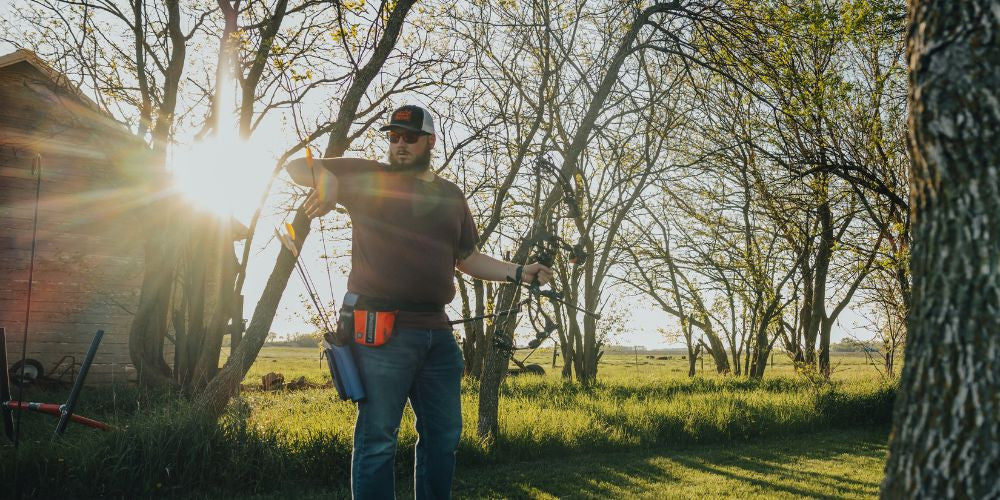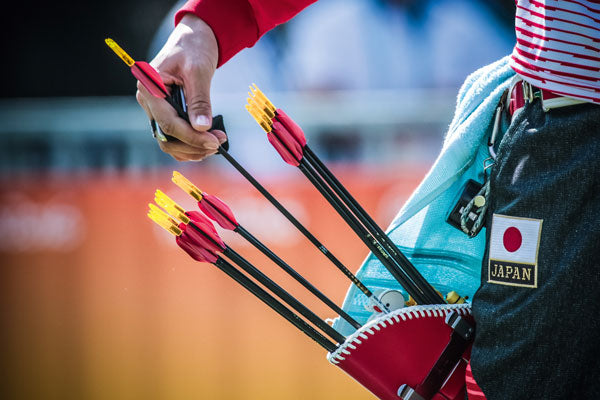One of the most important advancements in modern archery is the use of carbon arrows. Archery has been around for thousands of years, but advancements in technology and materials have made it possible for archers to achieve higher levels of accuracy and performance than ever before.
Carbon arrows offer a range of benefits over traditional arrows, including greater strength, lighter weight, and improved accuracy. But what makes a carbon arrow so different from other types of arrows, and what factors affect its performance? In this article, we will explore the mechanics of a carbon arrow in detail to give you a deeper understanding of this essential archery component.
Components Of A Carbon Arrow

A carbon arrow comprises several key components, each of which plays an important role in its performance. The primary components of a carbon arrow include the shaft, the nock, the point, the vanes or fletching, and the bowstring.
Shaft
The shaft is the main body of the arrow and is usually made from a high-strength carbon composite material. This material is chosen for its strength, durability, and ability to absorb energy, which helps reduce the amount of vibration transmitted to the shooter's hand. The diameter of the shaft, known as the "spine," is an important factor in determining the arrow's performance. The spine of an arrow refers to its stiffness, and arrows with different spines will bend and flex differently when shot. Choosing the right spine is essential for ensuring that the arrow flies straight and accurately.
Nock
The nock is a small component attached to the end of the shaft, and it provides a secure connection point for the bowstring. The nock is designed to fit snugly over the bowstring, and its shape and size are crucial for ensuring that the arrow is aligned correctly and launches consistently.
Point
The point is the tip of the arrow and is responsible for piercing the target. Points come in a variety of shapes and sizes, and the right point for a particular shooter will depend on the type of shooting they are doing. For example, hunters may prefer broadhead points, which are designed for maximum penetration,
while target archers may prefer field points, which have a smaller diameter and are less likely to cause damage to the target.
Vanes or Fletching
The vanes or fletching are small feathers or plastic blades attached to the back of the arrow. Their primary function is to stabilize the arrow in flight, helping to ensure that it flies straight and true. The number, shape, and size of the vanes or fletching can all affect the arrow's performance, and archers will often experiment with different configurations to find the setup that works best for them.
Science Behind The Flight Of A Carbon Arrow

The science behind the flight of a carbon arrow is complex and involves a number of factors, including the bow's draw weight, the arrow's spine, and the properties of the air through which it is flying. When the bowstring is released, the bow's energy is transferred to the arrow, causing it to begin moving forward. The vanes or fletching on the back of the arrow help to stabilize its flight and prevent it from veering off course.
The air around the arrow also plays a role in its flight. The air molecules create resistance, which slows the arrow down and can cause it to veer off course. The more aerodynamic the arrow, the less resistance it will encounter and the more consistently it will fly. This is why the shape and size of the arrow's point, vanes or fletching, and other components are so important.
The flight of a carbon arrow is governed by a number of physical laws and principles. To understand the science behind the flight of a carbon arrow, it is important to understand the basic principles of aerodynamics and mechanics.
Aerodynamics
Aerodynamics plays a critical role in the flight of a carbon arrow. The shape and orientation of the arrow and its vanes determine the lift and drag forces acting on the arrow during flight. The lift force is generated by the pressure differential between the front and rear of the arrow, while the drag force is generated by the friction of the arrow moving through the air. A properly designed arrow and vane system will generate enough lift to counteract the drag and maintain a stable flight path.
Center of Pressure
The center of pressure is the point on the arrow where the lift and drag forces acting on the arrow are balanced. The location of the center of pressure can affect the stability and accuracy of the arrow during flight. A properly designed arrow and vane system will have a center of pressure located near the center of the arrow, which will help to maintain stability and accuracy during flight.
Moment of Inertia
The moment of inertia is a measure of an object's resistance to rotational motion. The moment of inertia of an arrow is determined by its mass distribution, shape, and size. A properly designed arrow will have a low moment of inertia, allowing it to respond quickly to changes in its flight path and maintain stability and accuracy during flight.
Gyroscopic Stability
Gyroscopic stability refers to the tendency of an object to maintain its orientation in space as it rotates. The spinning vanes of a carbon arrow generate a gyroscopic effect that helps to stabilize the arrow during flight. The speed and orientation of the vanes, as well as the spin rate of the arrow, can all affect the gyroscopic stability of the arrow. Properly designed arrows and vane system will generate enough gyroscopic stability to maintain stability and accuracy during flight.
Factors Affecting The Accuracy And Performance Of A Carbon Arrow
The accuracy and performance of a carbon arrow are affected by a number of factors, including the bow's draw weight, the arrow's spine, and the properties of the air through which it is flying. In addition, the way the arrow is held and released can also affect its accuracy, as can any imperfections in the bow or the bowstring.
Arrow Straightness
Arrow straightness is one of the most critical factors affecting accuracy and performance. If an arrow is not straight, it will cause the arrow to fly in a less consistent manner, which can result in accuracy issues. The straightness of an arrow can be affected by a number of factors, including manufacturing defects, improper storage, and damage during transportation. Regular inspections of your arrows and using an arrow straightness gauge can help ensure your arrows are straight and in good condition.
Arrow Spine
The spine of an arrow refers to its flexibility or stiffness. The right arrow spine is crucial to achieving optimal accuracy and performance, as it affects the arrow's stability and flight path. The arrow spine needs to match the draw weight and draw length of the bow being used, as well as the arrow's weight. An arrow that is too stiff or too flexible can cause accuracy issues and affect performance.
Arrow Weight
Arrow weight is another important factor affecting accuracy and performance. An arrow that is too heavy or too light can cause the bow to shoot inaccurately. The arrow weight must match the bow and the draw weight, as well as the arrow's spine and length. Arrow weight can be affected by the materials used to make the arrow, as well as the accessories attached to the arrow, such as broadheads and vanes.
Arrow Rest and Nocking Point
The arrow rest and nocking point are important components of the bow and arrow setup and can significantly impact accuracy and performance. A poorly positioned arrow rest or nocking point can cause the arrow to be misaligned with the bow, resulting in accuracy issues. Proper positioning of the arrow rest and nocking point, and regular inspections of these components, can help ensure optimal accuracy and performance.
Arrow Vanes

The vanes on a carbon arrow play an important role in its stability and accuracy. The size, shape, and orientation of the vanes can affect the arrow's flight, so it is crucial to choose the right vanes for your bow and shooting style. Some archers prefer smaller, high-profile vanes, while others prefer larger, low-profile vanes. Experimenting with different types of vanes can help you determine which vanes work best for your bow and shooting style.
Bow Tuning
Finally, proper bow tuning is crucial to achieving optimal accuracy and performance. A poorly tuned bow can result in accuracy issues, as well as affect the arrow's stability and flight path. Regular bow tuning and the use of a bow scale and bow square can help ensure your bow is properly tuned and in good condition.
Arrow Dynamic Spine
Dynamic spine is a term used to describe the actual spine of an arrow as it is shot from a bow. The dynamic spine of an arrow can be affected by the bow's draw weight, the arrow's speed, and the arrow's length. A proper match between the bow and the arrow's dynamic spine is crucial to achieving optimal accuracy and performance. To determine an arrow's dynamic spine, you can use an arrow spine tester, which measures the arrow's bend as it is shot from a bow.
Broadheads

Broadheads are the cutting blades attached to the front of an arrow, and they can significantly impact accuracy and performance. The weight and design of the broadheads can affect the arrow's flight, stability, and accuracy. It is important to choose the right broadheads for your bow and shooting style and to properly balance the broadheads and vanes for optimal performance.
Arrow Release
The way an arrow is released from the bowstring can also affect its accuracy and performance. Proper arrow release technique involves a smooth, steady release, with the arrow being released at the same point on the bowstring every time. A proper release helps ensure that the arrow is properly aligned with the bow and released with consistent speed and trajectory. Improper release technique can result in accuracy issues and can also affect the stability and flight of the arrow.
Maintenance And Care Of Carbon Arrows
Carbon arrows are an investment, and proper maintenance and care can extend their lifespan and ensure their continued performance. Here are some more in-depth tips for maintaining and caring for your carbon arrows:
Cleaning and Inspecting
Regular cleaning and inspection of your carbon arrows are essential for ensuring their continued performance. After each use, use a soft cloth to remove any dirt or debris from the arrow shaft, vanes, and point. Additionally, you can use a soft-bristled brush to remove any dirt from the arrow grooves. Also, inspect the arrow for any damage, such as cracks, nicks, or bending. If you find any damage, replace the arrow to ensure that it does not compromise your safety or the accuracy of your shot.
When inspecting your arrows, pay close attention to the vanes and fletchings. Make sure that they are not bent or damaged, as this can affect the flight of the arrow. If necessary, you can use a vane straightener to realign the vanes. Additionally, inspect the nocks of your arrows, ensuring they are secure and not damaged. If necessary, you can use nock pliers to tighten the nocks or replace them if damaged.
Storing
Storing your carbon arrows correctly can help extend their lifespan. Always store your arrows in a dry and cool place, away from direct sunlight and extreme temperatures. Also, never store your arrows vertically, as this can cause the arrows to warp or bend. Instead, store them horizontally in a quiver or on a shelf.
When storing your arrows, ensure they are not in direct contact with any hard or sharp surfaces that can damage the vanes or fletchings. Additionally, make sure that they are not stacked on top of each other, as this can cause the arrows to become bent or damaged. Instead, store them in a quiver or a protective case, and ensure enough space between each arrow to prevent damage.
Transporting

When transporting your carbon arrows, take care to protect them from damage. Never store your arrows loose in a vehicle, as they can shift and become damaged. Instead, store them in a quiver or a protective case. Also, when traveling, ensure that your arrows are stored in the overhead compartment or under an airplane seat to prevent them from becoming damaged by baggage handlers.
When transporting your arrows, ensure they are not subjected to extreme temperatures, as this can cause them to become brittle and break. Additionally, make sure that they are not subjected to excessive vibrations or impacts, as this can cause the arrows to become damaged or bent.
Removing Points
Removing points from your carbon arrows can be a delicate process and should be done with care to avoid damaging the arrow shaft. First, loosen the point using an arrow puller. Then, gently twist the point in a counterclockwise direction until it is removed.
When removing points from your arrows, make sure that you are using the correct tools and techniques to avoid damaging the arrow shaft. Additionally, ensure that you are removing the points in a well-lit area, so you can clearly see what you are doing.
Lubrication
Lubricating your carbon arrow shafts can help reduce friction and extend their lifespan. Use a silicone-based lubricant and apply a small amount to the inside of the arrow shaft before inserting the point. This will help the arrow slide smoothly through the bow and reduce friction and wear.
Additionally, you can use bow string wax to lubricate the bowstring and reduce friction between the string and the arrow nock. However, be sure to only use a small amount, as excess wax can accumulate on the arrow and affect its flight. Additionally, make sure to wipe away any excess wax after lubricating the bowstring, as this can cause the arrow to become unbalanced and affect its flight.
Conclusion
Carbon arrows are a versatile and high-performing component of any archery setup. By understanding the mechanics of a carbon arrow, including its components, the science behind its flight, and the factors that affect its accuracy and performance, archers can make informed decisions about their equipment and get the most out of their shooting experience. Whether you are an experienced archer or just starting out, taking the time to learn about the mechanics of a carbon arrow is well worth the investment.
 cust@legendarchery.com
cust@legendarchery.com 302 503 5767
302 503 5767 Whitestown, In 47075
Whitestown, In 47075




